At Mixed-Up Files today, we’re thrilled to have author-illustrator Vikram Madan. Vikram talks about his new book A Hatful Of Dragons that comes out on April 21, 2020. He also shares his exciting publishing journey along with other writing tips.

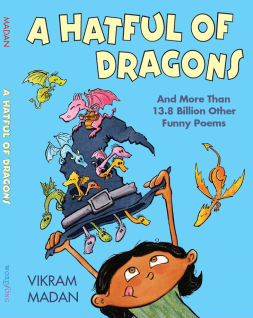
- Tell us about A Hatful Of Dragons. What inspired you to write the book?
‘A Hatful of Dragons: And More Than 13.8 Billion Other Funny Poems’ is a quirky, eclectic collection of funny rhyming poems woven together with rich illustrations featuring recurring characters and sub-plots – a double dose of visual and literary fun for all ages 7 and up.
As a kid I loved both cartooning and writing poems but never thought of combining the two till I encountered, much later in life, Shel Silverstein’s work. I was instantly attracted to the concept of words and images working together to create a funnier experience. So much so that ‘A Hatful of Dragon’ is my third collection of self-illustrated funny poems featuring intertwined words and drawings.
- What would you want readers to take away from A Hatful Of Dragons?
I would love for readers of all ages to come away from this book with the idea that you can have a lot of fun playing with language and also with a desire to read more rhyming poetry.
- What were some of the most fun and challenging parts about writing A Hatful Of Dragons?
The poems in my original manuscript were largely disconnected from each other. While shortlisting the poems, Rebecca Davis, my editor, instinctively zeroed-in on the uniqueness of creating cross-connections between poems. As I developed the illustrations for the book, I had a lot of fun thinking of ways to interconnect the poems visually. For example, a main character in one visual might show up later in the book as a secondary character in another visual, helping create a cohesive, but weird, universe for the characters. I hope kids will have fun closely inspecting the illustrations for cross-connections.
The most challenging part of the book was stuffing 13.8 billion poems into 64 pages. 🙂
Actually I found doing the illustrations to be a challenge as I underestimated the sheer physical work required to get through multiple rounds of revisions and changes. Somewhat like running a marathon, most enjoyable, not while you’re doing it, but well after it is done. 🙂
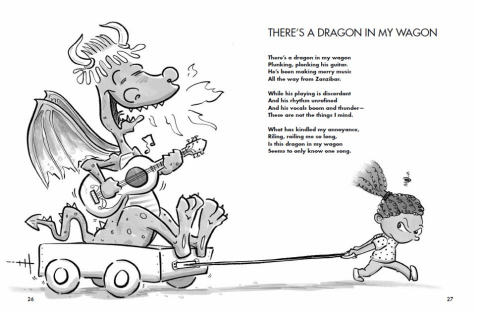
Another challenge was coming up with a distinctive title for the book. The title poem ‘A Hatful of Dragons’ did not exist in my original manuscript. We thought of titling the book ‘There’s a Dragon in My Wagon’ but an internet search showed half-a-dozen books already had that title. Many other title poems from the manuscript did not pass internal sales and marketing reviews. I finally proposed ‘A Hatful of Dragons’ and once that title was approved, I had to then write a title poem from scratch worthy of the book. Talk about pressure! 🙂
- You began your writing career by self-publishing your work. How did the experience influence you as a children’s writer? How did you make the transition from self-publishing to traditional publishing?
Prior to self-publishing, I spent a decade trying to have my rhyming picture books and themed poetry collections published. I found agents and publishers reluctant to consider poetry. With rejections piling up, I actually gave up writing and submitting for a few years. However the itch never went away. In 2012, I spent a summer writing a fresh collection of poems. I decided then that if no one would publish my poems, I would publish them myself, which led to my first collection ‘The Bubble Collector’.
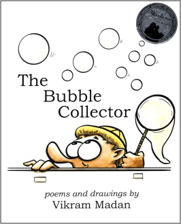
Once ‘The Bubble Collector’ was out, I realized writing the book was the easy part. Marketing, distribution, getting anyone to notice a self-published book, was incredibly hard (more so for us introverts!). I learnt that if I didn’t do the hustle, no one else would. With perseverance and leg work, I was able to get the book into local bookstores, gain a few favorable reviews and endorsements, and conduct some school visits. The book went on to win a 2013 Moonbeam Book Award for Children’s Poetry and was invited to apply to the 2014 WA State Book Awards. All in all, for a self-published poetry book, it did quite ok. The ‘hustling’, however, left me with deep appreciation for traditional publishing.
Upon completing the manuscript for my second collection (in 2015), I decided to give the traditional channel another shot. It took a year of querying agents before one, Rosemary Stimola at Stimola Literary Studios, expressed interest in the manuscript. (The modest success with the self-published book really helped my pitch). It took Rosemary another year to find a publisher, Boyds Mills & Kane. The publisher scheduled the book for a 2020 release, five years from when I finished the manuscript. Despite the slow pace of traditional publishing, I’ve really enjoyed working with my editors, Rebecca Davis and Barbara Grzeslo – the book is so much better than I could have made just by myself – and I’m looking forward to it being available everywhere without having to knock on doors, one at a time. 🙂
And since the second book was going to take five years, I squeezed out another self-published poetry collection, ‘Lord of the Bubbles’, in 2018, which went on to win a 2019 Moonbeam Award for Children’s Poetry.
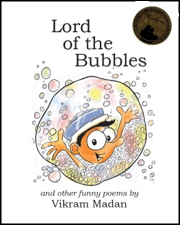
- If you could tell your younger writing self anything, what would it be?
Although I was writing and drawing from a really early age, I didn’t take my art seriously because I couldn’t see how to traverse the gap between what I made and what I admired. With no insight into the creative journey, the learning process, the blood, sweat, and tears that every piece of art demands, I did not believe in my own abilities. My epiphany came when one day, as an adult, I accidently wandered into an exhibition of original Dr. Seuss manuscripts. Typewritten sheets covered with frustrated scribbles, crossed out over and over again in search of better options. I was stunned to realize that the ‘genius’ was in the incessant revision, the twenty attempts before something worked, the trying, trying, trying and not giving up. Looking at those manuscripts was the first time I thought to myself, “Wait, if this is how it’s done, then maybe I can do this too!” Thank you Dr. Seuss – I wish I could have sent my younger self to see that!
- Do you have any other advice/tips for writers?
In visual-art circles the running joke is that ‘Only the first fifty years are the hardest’. In other words, the ‘successful’ artists are the ones who find ways to persist. The same is true for writers. Patience, persistence, working on your craft, and never giving up! (And if you do feel like giving up, read a book, any book, by creative coach Eric Maisel).
Here’s a cool flip-through video that Vikram made for the book: https://youtu.be/XswGM2FLlBM
Seattle-area Author-Artist Vikram Madan grew up in India, where he really wanted to be a cartoonist but ended up an engineer. After many years of working in tech, he finally came to his senses and followed his heart into the visual and literary arts. When not making whimsical paintings and public art, he writes and illustrates funny poems. His books include ‘The Bubble Collector’, ‘Lord of the Bubbles’, and ‘A Hatful of Dragons’. Visit him at www.VikramMadan.com
Want to own your very own ARC of A Hatful Of Dragons? Enter our giveaway by leaving a comment below!
You may earn extra entries by blogging/tweeting/facebooking the interview and letting us know. The winner will be announced here on March 2, 2020 and will be contacted via email and asked to provide a mailing address (US/Canada only) to receive the book.

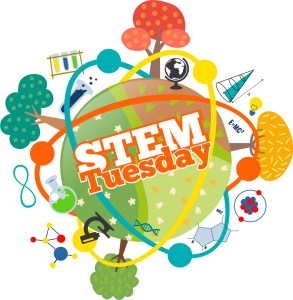
 Today we’re interviewing Sara Latta, author of
Today we’re interviewing Sara Latta, author of 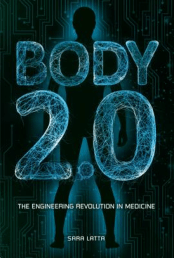 Sara Latta: Thanks for having me on your blog! Body 2.0 explores the ways in which engineering, science, and medicine are coming together to make some remarkable advances in the fields of tissue engineering and regenerative medicine, neuroscience, microbiology, and synthetic biology. I begin the book with a brief history of biomedical engineering—arguably the first known example of which was a wooden toe found on an ancient Egyptian mummy—but primarily the book focuses on cutting-edge research and the scientists at the forefront of the research. That was important to me; much of the work I write about hasn’t even reached clinical trials. I wanted to show readers that they could jump into this research at a very exciting time.
Sara Latta: Thanks for having me on your blog! Body 2.0 explores the ways in which engineering, science, and medicine are coming together to make some remarkable advances in the fields of tissue engineering and regenerative medicine, neuroscience, microbiology, and synthetic biology. I begin the book with a brief history of biomedical engineering—arguably the first known example of which was a wooden toe found on an ancient Egyptian mummy—but primarily the book focuses on cutting-edge research and the scientists at the forefront of the research. That was important to me; much of the work I write about hasn’t even reached clinical trials. I wanted to show readers that they could jump into this research at a very exciting time.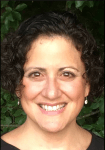 Your host is
Your host is 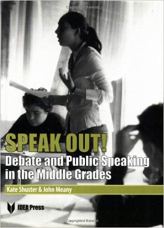 Speak Out! Debate and Public Speaking in the Middle Grades
Speak Out! Debate and Public Speaking in the Middle Grades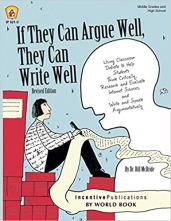 If They Can Argue Well, They Can Write Well
If They Can Argue Well, They Can Write Well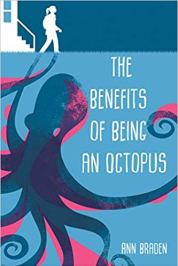 The Benefits of Being an Octopus
The Benefits of Being an Octopus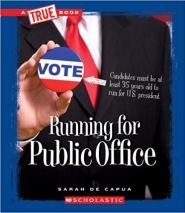 Running for Public Office
Running for Public Office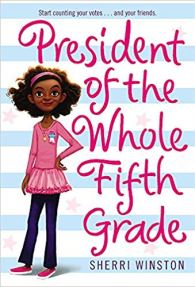 President of the Whole Fifth Grade
President of the Whole Fifth Grade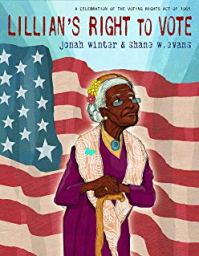 Lillian’s Right to Vote
Lillian’s Right to Vote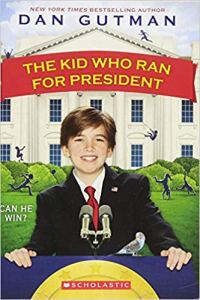 The Kid Who Ran for President
The Kid Who Ran for President